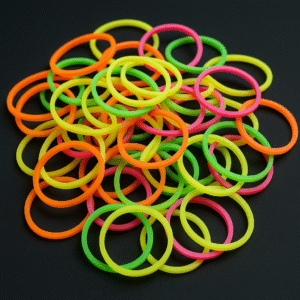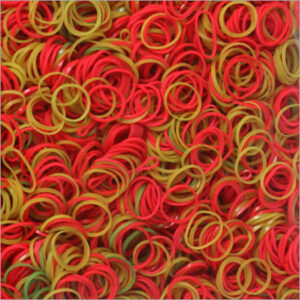Understanding Rubber Band Compression: The Unseen Force
When we think about the physics of a rubber band, our minds almost always leap to the concept of tension. We think about stretching it, about the force it exerts as it tries to pull back. However, there is another, equally important, and often unseen force at play: compression. While a rubber band is known for its ability to stretch, its behavior under compression is a fascinating and important aspect of its material science. Understanding how a rubber band behaves when it is squeezed, rather than pulled, is key to appreciating its full range of product properties and to understanding its role in a variety of specialized applications.
This guide will provide a deep dive into the concept of rubber band compression, exploring the science behind it, how it is measured, and why it is a crucial property for everything from creating a high-performance, bouncy ball to engineering a perfect, pressure-resistant seal.
The Science of Compression: What Happens When You Squeeze?
Compression is the application of a force that pushes on or squeezes a material, attempting to reduce its volume. While we think of rubber as being stretchy, it is also, like most solids, highly incompressible.
- Incompressibility: This means that it is very difficult to change the actual *volume* of a piece of rubber. When you squeeze a rubber block, you are not really making it smaller; you are just causing it to bulge out in a different direction. This property is known as Poisson’s ratio. A material with a high Poisson’s ratio (like rubber) will expand a great deal in one direction when it is compressed in another.
– Compression Set: This is the most important property related to compression. A “compression set” test measures a material’s ability to return to its original thickness after it has been subjected to a constant compressive force for a long period of time. A material with a low compression set is one that has a good “memory” and will spring back to its original shape. A material with a high compression set will remain permanently squashed and deformed.
How is Compression Set Measured?
In our R&D lab, we perform compression set tests to evaluate the quality and durability of our rubber compounds.
- A small, standard-sized cylindrical “button” of the rubber compound is measured for its original thickness.
- This button is then placed in a device where it is compressed by a specific amount (e.g., squashed to 75% of its original height).
- The device is then placed in an oven at an elevated temperature for a set period of time (e.g., 22 hours at 70°C). The heat is used to accelerate the aging and deformation process.
- After the time has elapsed, the sample is removed from the device and is allowed to cool for 30 minutes.
- The final thickness of the rubber button is then measured.
The “compression set” is the percentage of the original deflection that the material *did not* recover. A lower number is better. For example, a compression set of 10% means the material recovered 90% of its original shape, which is an excellent result. A compression set of 80% means the material is almost completely flat and has very poor elastic memory under compression.
Why is a Low Compression Set So Important?
A low compression set is a hallmark of a high-quality, well-cured rubber compound. It is a crucial product property for any application where the rubber will be used as a seal, a gasket, or a shock absorber.
The Gasket and Seal Application:
Imagine a rubber “O-ring” or a gasket used to create a seal between two parts of a machine. The seal works because the rubber is compressed, and its elastic nature causes it to push back against the two surfaces, filling the gap.
- The Role of Compression: A rubber compound with a low compression set will continue to push back with a strong, consistent force for a very long time, maintaining a perfect seal. A compound with a high compression set will quickly become flat and deformed, losing its “push back” force and allowing the seal to leak.
The Shock and Vibration Absorber Application:
Rubber is an excellent material for absorbing shock and vibration precisely because of its elastic properties under compression.
- The Role of Compression: When a rubber motor mount or a vibration-damping pad is subjected to a vibration, it is being rapidly compressed and released. A material with a low compression set will spring back perfectly after each compression, ready to absorb the next vibration. A material with a high compression set will quickly become “packed down” and will lose its ability to absorb any further energy.
The Rubber Band Ball: A Celebration of Compression
One of the most fun and intuitive demonstrations of rubber’s properties under compression is the classic rubber band ball.
- The Science of the Bounce: When a rubber band ball hits the ground, its bottom surface is rapidly compressed. The massive amount of stored potential energy in the thousands of tightly wound bands resists this compression and then pushes back with an enormous amount of force, launching the ball high into the air. A ball made from high-quality rubber bands with a good compression set will be much bouncier than a ball made from old, degraded bands that have lost their elastic memory.
Conclusion: The Unseen Strength
The study of compression reveals a hidden and fascinating aspect of rubber’s material science. While we may not think about it as often as we think about tension, a rubber’s ability to resist permanent deformation under a compressive force is a critical indicator of its quality and durability. A low compression set is a direct result of a superior rubber compound and a perfect vulcanization process. It is one of the many unseen but essential product properties that we engineer into our materials to ensure they provide the highest possible level of performance, whether they are being stretched, squeezed, or bounced.






